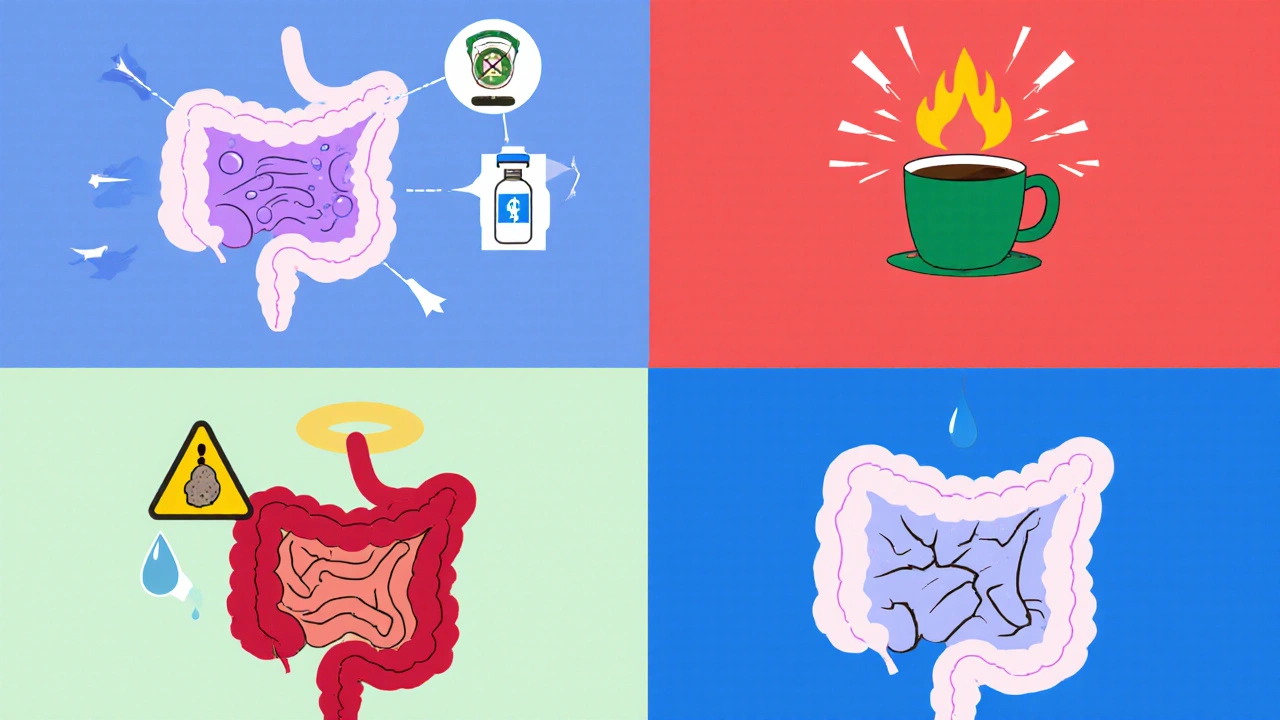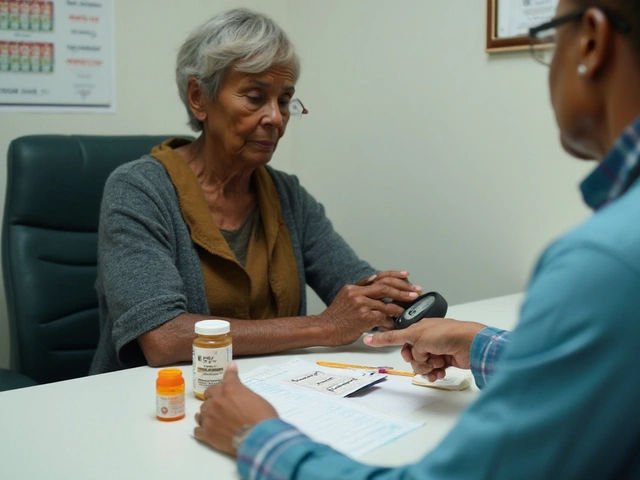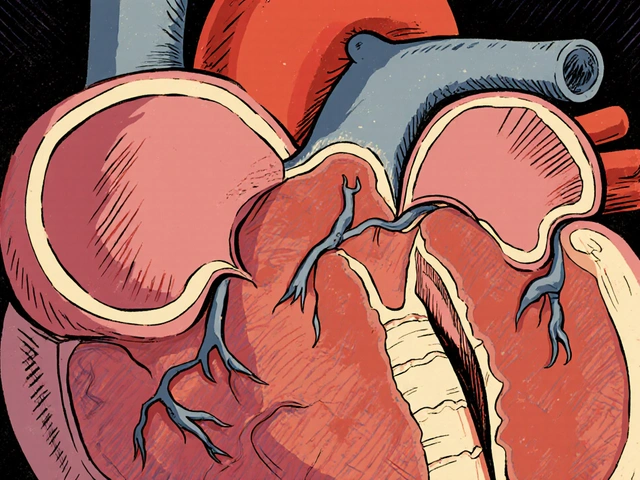Stomach Ache & Weight Loss Symptom Checker
Enter your symptoms and click "Check Possible Causes" to identify potential reasons for your stomach discomfort during weight loss.
Ever notice a nagging stomach ache right after you slash your calories? You’re not alone-many people chasing weight loss hit that uncomfortable rumble. Understanding why the two often appear together can help you keep the pounds off without the pain.
What is a stomach ache?
A stomach ache, or abdominal pain, is any discomfort felt in the area between the chest and the pelvis. It can range from a mild pang to a sharp cramp and might be fleeting or chronic. While occasional indigestion is normal, persistent pain deserves a closer look, especially when you’re on a weight‑loss plan.
Defining weight loss
In simple terms, weight loss means reducing total body mass, typically by creating a calorie deficit. Most diets aim for a deficit of 500-750 calories per day, which should translate to about 1-1.5 pounds per week. However, the body can react in unexpected ways, and stomach discomfort is a common side effect.
Why Does Cutting Calories Trigger Stomach Pain?
- Calorie deficit: When you eat fewer calories, your digestive system receives less food, which can slow gastric motility and cause bloating or cramping.
- Nutrient deficiency: Dropping certain foods can lead to low fiber, magnesium, or calcium, all of which keep the gut moving smoothly.
- Increased stomach acid: Skipping meals often causes the stomach to produce acid on an empty lining, leading to gastritis‑like sensations.
These factors are interlinked, meaning a single change in your diet can set off a chain reaction of discomfort.
Key Health Conditions That Mimic Diet‑Related Discomfort
Sometimes the pain isn’t just a side effect-it signals a deeper issue that can be aggravated by dieting. Below are the most common culprits.
| Condition | Typical Trigger | Symptoms Beyond Pain | When to Seek Help |
|---|---|---|---|
| Irritable bowel syndrome (IBS) | Low‑fiber, high‑protein diets | Bloating, irregular bowel movements | Symptoms > 3 months or worsening |
| Gastritis | Skipping meals, excess caffeine | Nausea, burning after meals | Bleeding, weight loss > intended |
| Gallbladder disease | Rapid fat reduction, high‑fat “cheat” meals | Upper‑right pain, jaundice | Severe pain or fever |
| Dehydration | Insufficient water with high‑protein intake | Dark urine, dizziness | Persistent cramps despite fluids |

How to Spot a Warning Sign
When you’re dieting, a few aches are normal, but certain red flags mean you should pause and reassess:
- Pain lasting longer than a few hours after eating.
- Accompanying symptoms like vomiting, blood in stool, or unexplained fever.
- Weight loss that exceeds your target (more than 2pounds per week).
- Persistent nausea or loss of appetite.
If any of these appear, consider a quick chat with your GP or a registered dietitian.
Practical Ways to Ease Stomach Discomfort While Losing Weight
- Eat regular, balanced meals: Even a 200‑calorie snack every 3‑4 hours can keep acid levels stable.
- Boost fiber gently: Add a spoonful of chia seeds or a small serving of oats to avoid sudden gas spikes.
- Stay hydrated: Aim for at least 2liters of water daily; herbal teas like ginger can soothe the gut.
- Limit irritants: Cut back on caffeine, alcohol, and overly spicy foods while your stomach adjusts.
- Mindful chewing: Chew each bite 20-30 times to reduce the workload on your digestive enzymes.
These tweaks don’t just calm your belly-they also support sustainable, healthy weight loss.
When Professional Guidance Is Worth It
A qualified dietitian can tailor a plan that meets your calorie goals without compromising gut health. They’ll assess:
- Your current macronutrient split (protein, carbs, fats).
- Micronutrient status-especially magnesium, which relaxes intestinal muscles.
- Potential food intolerances that might flare up under a new regimen.
In many cases, a small adjustment-like swapping a high‑acid fruit for a low‑acid one-solves the problem without derailing your progress.
Long‑Term Outlook: Keeping the Scale Moving Without Pain
Consistent, moderate weight loss is far more successful than drastic cuts that trigger stomach upset. Aim for a steady 0.5-1% of body weight per week, and monitor how your gut feels. If you notice a pattern-pain after a specific food or at a particular time of day-log it. Over weeks, the data will reveal whether a simple diet tweak or a deeper medical check is needed.
Frequently Asked Questions
Can a calorie deficit directly cause stomach ulcers?
A deficit alone rarely creates ulcers, but chronic empty‑stomach periods increase acid exposure, which can irritate the lining and contribute to ulcer formation over time.
Is it safe to use over‑the‑counter antacids while dieting?
Occasional use is fine, but relying on them daily can mask underlying issues and affect nutrient absorption. Talk to a pharmacist or doctor if you need them for more than a week.
How much fiber should I aim for on a low‑calorie diet?
Even on 1,200-1,400 calories, target 25-30grams of fiber per day, split across meals. This supports digestion without adding many calories.
Could dehydration be the hidden cause of my cramps?
Yes. Low water intake, especially with high‑protein meals, can lead to hard stools and cramping. Aim for 2L of water plus electrolytes if you sweat a lot.
When should I see a doctor for stomach pain during weight loss?
If pain is severe, lasts more than a few days, or is accompanied by vomiting, blood, fever, or unexpected rapid weight loss, schedule a medical appointment promptly.






20 Comments
Totally get that stomach pain can mess with your diet.
Skipping meals to cut calories can leave your stomach screaming for food, especially if you’re low on fiber. Adding a tiny snack every few hours can keep that acid from ramping up, and you won’t feel like you’re starving. It’s a simple tweak that makes a big difference :)
So apparently the whole "cutting calories equals a happy gut" myth is nothing more than a convenient lie fed to diet junkies.
The stomach isn’t a black hole that just swallows whatever you throw at it; it’s a sophisticated organ that reacts to nutrient fluxes.
When you slash carbs and fiber out of your plate, you’re basically telling your colon to go on strike.
The resulting dysbiosis shows up as cramping, bloating, and that dreaded ache you keep mentioning.
Add to that the fact that most low‑calorie plans are also low‑water, which only compounds the problem by dehydrating the mucosal lining.
The acid‑producing parietal cells then get a free‑run because there’s no food to buffer the pH, leading to gastritis‑like sensations.
If you think that a random handful of almonds will fix everything, you’re missing the bigger picture of macronutrient balance.
A proper approach should incorporate at least 25 grams of soluble fiber per day, even if that means counting a spoonful of chia seeds.
And don’t forget electrolytes; sodium and magnesium are crucial for smooth muscle contraction in the intestines.
People who ignore these basics often end up chasing quick fixes like antacids, which just mask the root cause.
In fact, chronic antacid use can interfere with calcium absorption, creating a feedback loop of deficiency and pain.
The literature on diet‑induced IBS shows that the gut microbiome shifts dramatically within weeks of a high‑protein, low‑fiber regimen.
That shift produces gas‑forming bacteria, which explains the sudden bloating you’re experiencing.
So, before you blame your “stomach” for being weak, examine the macro‑micronutrient composition of your plan.
In short, a balanced, nutrient‑dense diet paired with adequate hydration will keep the ache at bay and let you lose weight without the drama.
It’s fascinating how the mind can convince the gut that it’s under attack when you’re simply under‑fueling it. The body’s alarm system is wired for survival, not for a trendy calorie deficit.
Sure, because “a tiny snack every few hours” is the secret sauce, not the fact that most of those “snacks” are just sugar‑laden junk that will sabotage any weight loss effort. Also, your sentence structure could use a comma before “especially”.
Yo, ditch the starving game and give your gut some love – think rainbow bowls, not empty plates 🤘🌈. Your stomach will thank you with less drama and more energy.
I hear you! Adding a splash of color with veggies and a drizzle of olive oil not only tastes better but also keeps digestion smooth as butter.
Let’s be crystal‑clear!!!;; The premise that “calorie restriction = stomach pain” is a simplistic fallacy; you are ignoring the complex interplay of hormones, gut flora, and nutrient timing!!!;; If you truly want results, stop treating your body like a disposable experiment and adopt a scientifically‑backed protocol.
Exactly!!!; It’s about balance, not brute‑force; incorporate proper hydration, moderate protein, and steady fiber intake; your gut will respond positively, and you’ll avoid the pitfalls of extreme dieting.
From a physiological standpoint, sustained negative energy balance precipitates alterations in gastrin secretion, which may manifest as epigastric discomfort. It is advisable to implement a structured meal plan that aligns macronutrient distribution with circadian rhythms 😊.
Great, another “science” post that says eat on a schedule – genius.
Data shows that individuals who maintain a steady intake of 30 g of fiber daily experience a 20 % reduction in diet‑related abdominal pain, underscoring the importance of fiber.
Wow, that’s amazing! It really shows how a simple tweak can transform your journey – keep it up and the scale will move without the agony.
The industry wants you to believe stomach pain is just a “minor side effect,” but it’s actually a signal that your metabolism is being sabotaged by hidden additives in processed diet foods.
Just add a bit more water and some veggies, and you’ll feel the difference.
While the simplicity of hydration and vegetable intake is appealing, one must also consider the psychosomatic dimensions of self‑imposed caloric deprivation, which can engender a cascade of neuroendocrine disturbances.
Remember to listen to your body’s cues; if the pain persists, consulting a healthcare professional is the safest route.
Absolutely – a personalized assessment can pinpoint nutrient gaps and suggest gentle adjustments, ensuring your weight‑loss goals are met without compromising gut health.
They dont want u to know that the “quick diet hacks” are just a way to keep us all hooked on their products 😒💊.
Interesting theory, but “dont” should be “don’t” and “u” is, well, not proper English.
Write a comment